Sensor cable
- Summary
- Abstract
- Description
- Claims
- Application Information
AI Technical Summary
Benefits of technology
Problems solved by technology
Method used
Image
Examples
example 1
A sensing wire was prepared by extruding a layer of carbon-filled polyvinylidene fluoride (0.011 inch / 0.028 cm) over a first 30 AWG (0.010 inch / 0.025 cm diameter) solid Alloy 294 wire conductor. A second sensing wire was prepared in the same manner. An insulating wire was prepared by extruding a layer of polyvinylidene fluoride over a 24 AWG (0.025 inch / 0.064 cm diameter) solid tin-plated copper wire to give an outer diameter of approximately 0.054 inch (0.137 cm). A second insulating wire was prepared in the same manner. The polymer layers of the sensing wires and the insulating wires were then irradiated to 10 to 15 Mrad. The sensing wires were then dip coated in non-conductive polyurethane. Each of the sensing wires having a non-conductive surface layer had an outer diameter of approximately 0.036 inch (0.091 cm).
A central support member was prepared by extruding two layers of ethylene / tetrafluoroethylene copolymer to a total of 0.008 inch (0.020 cm) over a 16 AWG (0.060 inch / 0.1...
example 2
A sensing wire was prepared by extruding a first layer of carbon-filled polyvinylidene fluoride (0.011 inch / 0.028 cm) over a first 30 AWG (0.010 inch / 0.025 cm diameter) solid Alloy 294 wire conductor. A second sensing wire was prepared in the same manner. An insulating wire was prepared by extruding a layer of polyvinylidene fluoride over a 24 AWG (0.025 inch / 0.064 cm diameter) solid tin-plated copper wire to give an outer diameter of approximately 0.054 inch (0.137 cm). A second insulating wire was prepared in the same manner. The polymer layers of the sensing wires and insulating wires were then irradiated to 10 to 15 Mrad.
A central support member was prepared by extruding two layers of ethylene / tetrafluoroethylene copolymer to a total of 0.008 inch (0.020 cm) over a 16 AWG (0.060 inch / 0.152 cm) diameter stranded nickel-plated copper wire to give an outer diameter of approximately 0.077 inch (0.196 cm). Using a 1.5 inch (3.8 cm) extruder, a core member was prepared by extruding an...
PUM
 Login to View More
Login to View More Abstract
Description
Claims
Application Information
 Login to View More
Login to View More - R&D
- Intellectual Property
- Life Sciences
- Materials
- Tech Scout
- Unparalleled Data Quality
- Higher Quality Content
- 60% Fewer Hallucinations
Browse by: Latest US Patents, China's latest patents, Technical Efficacy Thesaurus, Application Domain, Technology Topic, Popular Technical Reports.
© 2025 PatSnap. All rights reserved.Legal|Privacy policy|Modern Slavery Act Transparency Statement|Sitemap|About US| Contact US: help@patsnap.com



